Mickey Cochrane
After his professional baseball career, he served in the United States Navy in World War II and ran an automobile business.
He hit third more often, but whatever his place in the order his primary role was to get on base so that hard-hitting Al Simmons and Jimmie Foxx could drive him in.
[9] He ended his rookie season with a .331 batting average and a .397 on-base percentage, helping the Athletics to a second-place finish.
However, in his book The Life of a Baseball Hall of Fame Catcher, author Charlie Bevis cites the Philadelphia pitching staff's carelessness in holding runners as a contributing factor.
[12] In 1934, Mack started to disassemble his dynasty for financial reasons and put Cochrane on the trade block.
Navin had originally hoped to acquire Babe Ruth and name him player-manager, but after those talks fizzled, he turned to the A's.
[14] A deal to send Cochrane to Detroit was quickly arranged, and Navin immediately named him player-manager.
[6] It was with Detroit where Cochrane cemented his reputation as a team leader and his competitive nature drove the Tigers, who had been picked to finish in fourth or fifth place, to the 1934 American League championship, their first pennant in 25 years.
[17] Cochrane's leadership and strategic skills won him the 1934 Most Valuable Player Award, shocking considering that Lou Gehrig had won the Triple Crown, compiled a 10.0 WAR (Wins Above Replacement) rating which was more than double that of Cochrane's and utterly dominated the league in every major offensive category.
[19] In late 1935, the Detroit Free Press speculated Cochrane might eventually succeed Navin as team president.
[20] Due in part to his high-strung nature, as well as considerable pressure to join the Black Legion (political movement), then-prominent in the Detroit area, he suffered a nervous breakdown during the 1936 season.
[2] He led American League catchers six times in putouts and twice each in double plays assists and fielding percentage.
[29] Despite his head injury, Cochrane served in the United States Navy during World War II.
[3][6] Commissioned as a lieutenant and assigned to Naval Station Great Lakes, he oversaw physical training of new recruits and coached the baseball team.
[31] In 1947, Cochrane became the third catcher enshrined in the Baseball Hall of Fame, after Roger Bresnahan and Buck Ewing.
[2][39] In 2013, the Bob Feller Act of Valor Award honored Cochrane as one of 37 Baseball Hall of Fame members for his service in the United States Navy during World War II.
